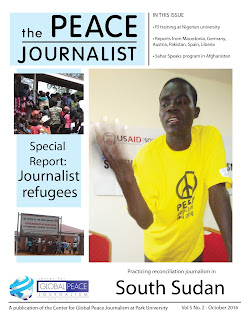A busy 2016 to be followed by busier 2017
As I look back on 2016, I’m encouraged by what seems to me
like growing interest in peace journalism generally and in the activities of
the Center for Global Peace Journalism. Here is a partial list of our
activities in 2016:
Kansas City area presentations: League of Women Voters; Johnson
County Community College (JCCC) visiting scholar; Peacebuilding Conference
(Park University and JCCC).
Others: Alliance for Peacebuilding in Washington, DC; Juba, South Sudan; Munich, Germany;
Klagenfurt, Austria; Salzburg, Austria; Freetown, Sierra Leone; Costa Rica (at
the University for Peace).
Aborted, attempted workshop: Chennai, India (see previous
post).
Publishing: Two editions of the Peace Journalist magazine;
First US published peace journalism textbook—Peace Journalism Principles and Practices.
In a bored (ha!) moment, I produced this map to show where I’ve
taught PJ. I’m not sure if this is a testament to my energy or my insanity. (Click on map to enlarge)
2017 promises to be just as busy.
The signature project of 2017, and 2018-19 as well, is still
in the planning stages, and can’t be officially announced until all the
agreements are signed. I can say that it will involve me teaching several
seminars in Nigeria in May, then bringing back 12 Nigerian journalists to Park
University for a semester-long fellowship in the fall. Our partner in this
project is one of the world’s most respected humanitarian organizations.
I also have plans to teach peace journalism projects in
Cameroon and Pakistan, and to give at least several presentations here in the
US, at the IVOH Annual Media Summit in New York in June, and at the NationalArchives in Kansas City in January. Of course, Park University and JCCC will
also sponsor the fifth annual peacebuilding conference in late October or early
November.
We’ll talk more in 2017. Happy New Year!




